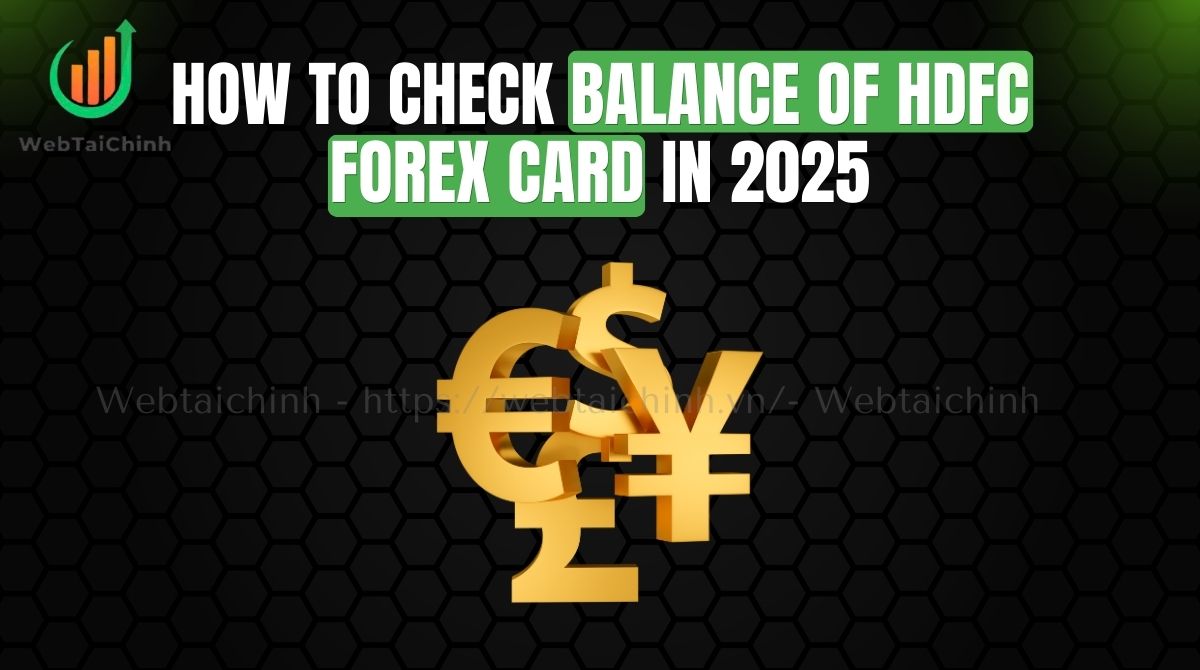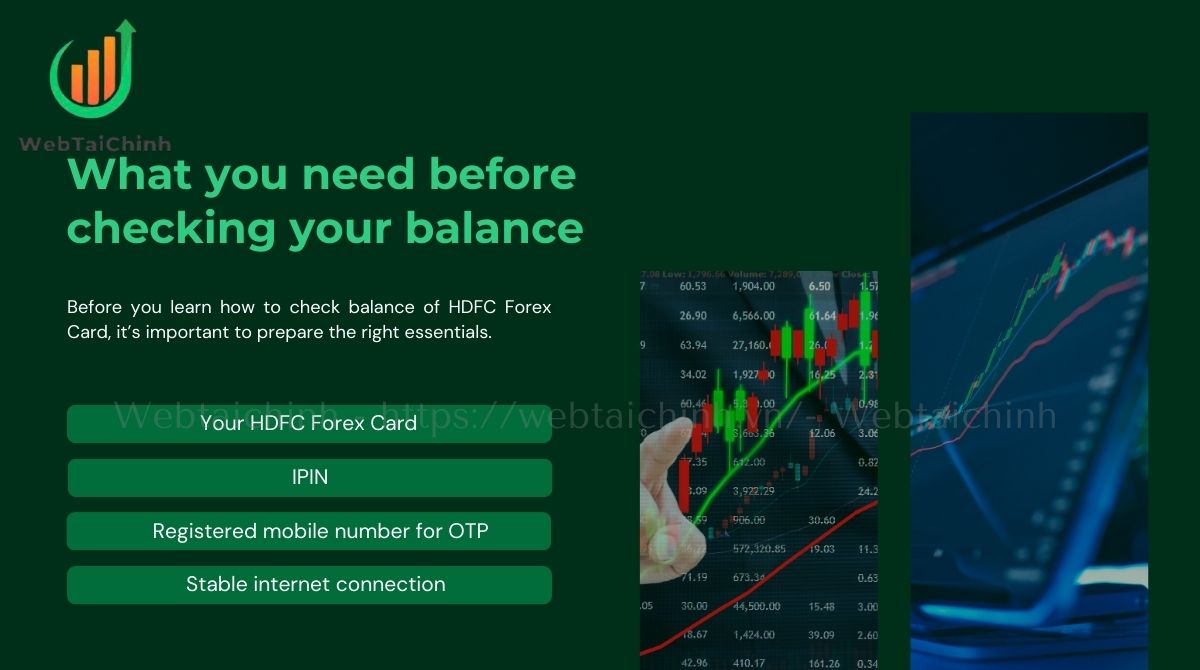Physical Address
304 North Cardinal St.
Dorchester Center, MA 02124
Physical Address
304 North Cardinal St.
Dorchester Center, MA 02124

For anyone traveling or studying abroad, keeping track of funds is essential. That’s why knowing how to check balance of HDFC Forex Card becomes a key skill for cardholders in 2025. From online portals and mobile apps to PhoneBanking and ATMs, HDFC offers multiple secure options to monitor your balance anytime, anywhere.
This guide walks you through every method step by step, helping you stay in control of your money with ease.
Key takeaways:
| Method | How to use | Pros | Cons | Tip |
| HDFC Forex/Prepaid Portal | Login with card number and IPIN on the official website | Comprehensive details, multi-currency view | Requires internet & IPIN, possible phishing risks if careless | Use only official URL and bookmark it |
| HDFC Mobile Banking App | Access ‘Cards’ section after app login | Fast, biometric security, transaction export | Needs smartphone & updated app version | Enable notifications for real-time alerts |
| HDFC PhoneBanking | Dial dedicated Forex Card helpline, follow IVR prompts | Works offline, available 24/7 globally | Verification process can be time-consuming | Keep card information ready before calling |
| International ATMs | Insert card, select Balance Inquiry | Accessible worldwide without internet | ATM charges and DCC fees may apply | Avoid DCC prompts, choose local currency |
Before you learn how to check balance of HDFC Forex Card, it’s important to prepare the right essentials. Without the correct card details, IPIN, and registered mobile number, you may face errors or failed login attempts.

This section outlines exactly what you need in advance to ensure a smooth and secure balance inquiry process.
If you haven’t received your IPIN or have forgotten it, don’t worry you can generate or reset it via official channels using your registered mobile number. Always keep these credentials private to protect your funds and avoid unauthorized access. Ensuring these essentials upfront guarantees a smooth balance check experience.
One of the most convenient ways to manage your travel money is learning how to check balance of HDFC Forex Card through the official online portal. The HDFC Forex/Prepaid Card portal gives you instant access to multi-currency balances, transaction history, and account details from anywhere in the world. In this section, you’ll find everything you need from preparing your first login to following step-by-step instructions and troubleshooting common issues.
Your User ID is usually your Forex Card number printed on the card. The IPIN is a 6-digit password sent with your welcome kit or set up online. This IPIN functions like an ATM PIN but is used for logging into the portal or app.
For first-time login, you may be required to change your IPIN to something secure and memorable. If forgotten, you can reset it via the “Forgot IPIN” option. Always use the official HDFC Forex Portal URL (https://www.hdfcforex.com) to avoid phishing scams.
Tip: Bookmark the official portal and avoid clicking links from untrusted emails.
Annotated screenshots on the portal guide you clearly through these steps, making the process intuitive.
| Issue | Solution |
| Invalid IPIN error | Use “Forgot IPIN” link to reset after verifying your registered mobile number. |
| Account not activated | Activate your Forex Card online or contact HDFC support to confirm activation. |
| Browser compatibility problems | Use updated browsers like Chrome or Firefox and clear cookies/cache before retrying. |
If issues persist, contact HDFC customer care with your card details and registered information handy.
Another fast and secure option for travelers is learning how to check balance of HDFC Forex Card using the official HDFC Mobile Banking App. With just a few taps, you can view balances across multiple currencies, track recent transactions, and even export statements for record keeping. This section will guide you through the app setup, prerequisites, and step-by-step process to ensure you always have your card balance at your fingertips.
Keeping the app updated prevents security vulnerabilities and ensures compatibility with new features.
Sometimes, internet access isn’t available, or you may prefer a direct voice service for quick assistance. In such cases, PhoneBanking becomes a reliable alternative to stay updated on your card balance. With round-the-clock availability and multilingual support, it ensures peace of mind no matter where you are. This section explains when to use PhoneBanking, how the call flow works, and what to do if you need help from a live agent.
PhoneBanking is especially useful in scenarios where internet access is unavailable or during emergencies. It offers a 24-hour support service across many locations, allowing users to get balance information simply by calling the relevant helpline.

If you encounter problems such as card blockage, unknown transactions, or require IPIN reset, request to speak with a live agent during your call. Provide only necessary information and avoid sharing full card details to maintain security.
ATMs provide a simple and widely accessible way to check your card balance while traveling, whether you are in India or abroad. This method works even without internet access, making it a practical choice during trips. In this section, you’ll learn about compatible ATM networks, possible fees, and the exact steps to follow for a quick balance inquiry.
| Network | Notes |
| Visa/Mastercard ATMs Globally | Check Visa or Mastercard logo on ATM; suitable for Forex Cards |
| Local Banks | May charge fees or offer limited service; DCC prompts common |
Fee warning: Some ATMs levy withdrawal or inquiry fees. Dynamic Currency Conversion (DCC) prompts may appear, offering transactions in your home currency but often at unfavorable rates. To avoid extra charges, always opt to pay in the local currency of the country.
For optimal accuracy, cross-check ATM balances with online or app views, considering currency conversion timing and rates.
When learning how to check balance of HDFC Forex Card, it’s important to know that the numbers you see may not always match across platforms. That’s because your account shows different types of balances available, ledger, and pending.

This section breaks down what each type means, why they sometimes differ, and how to interpret them correctly for better financial control.
| Balance type | Definition |
| Available balance | The funds currently accessible for spending or withdrawal. |
| Ledger balance | Total amount including pending/held transactions up to the last update. |
| Pending transactions | Authorizations not yet settled (e.g., hotel pre-authorizations or car rentals). |
Since HDFC Forex Cards support multi-currency wallets, balances in different currencies may convert dynamically depending on usage and location. Holds on funds typically last a few days, varying by merchant type. Understanding these distinctions helps explain why your balance might appear to differ between checks.
If you’re unable to log in while trying to learn how to check balance of HDFC Forex Card, the issue often comes down to a forgotten or missing IPIN. The IPIN acts as your secure login password, and without it, access to the portal, app, or PhoneBanking isn’t possible. This section explains how to quickly reset or generate a new IPIN using official methods, ensuring uninterrupted and safe access to your account.
Always keep your IPIN confidential and choose a secure code to prevent unauthorized access.
An easy way to stay updated without constantly logging in is by enabling alerts while managing how to check balance of HDFC Forex Card. With SMS, email, and app push notifications, you can receive instant updates about low funds, recent transactions, or unusual activity. This section shows you how to set up these alerts so your balance information is always at your fingertips.
Automatic alerts reduce the need for constant manual balance checks and alert you instantly to suspicious activity or low balances.
Even with multiple reliable methods available, technical issues or account errors can still occur from time to time. From login failures to discrepancies in displayed balances, these problems can cause unnecessary stress if you don’t know how to handle them. This section covers the most common issues users face and provides quick fixes, along with guidance on when to escalate the matter to customer support.
If your balance doesn’t update or you notice missing transactions, it may be due to transaction settlement delays. For blocked cards or suspected fraud, immediately contact HDFC support to raise disputes or request card blocking to secure funds.
Beyond just checking balances, understanding the cost structure and usage limits of your card is essential for smart money management. Every Forex Card comes with specific fees, daily limits, and policies that can affect how you spend and withdraw funds. In this section, we’ll break down the common charges, restrictions, and conditions you should be aware of before relying on your card abroad.
While accessing your card details is convenient, it also comes with potential security risks if not done carefully. Protecting your personal information and funds should always be a top priority. This section highlights essential safety practices to follow both online and at ATMs, so you can manage your card confidently without exposing yourself to fraud or hidden charges.
Following these practices safeguards your card against fraud and unauthorized use.
See more articles in this category:
No. You can access the portal using your card number and IPIN.
Yes. Using the portal, app, PhoneBanking, or ATMs.
In the welcome kit or by generating online.
Currency conversion timing and ATM network may cause differences.
Both are secure; app offers biometric login for added convenience.
No. Authentication via IPIN and OTP is mandatory for security.
Managing your travel expenses becomes much simpler once you know how to check balance of HDFC Forex Card using the official methods. Whether you prefer the web portal, mobile app, phone service, or ATMs, the process is secure and accessible worldwide. For more reliable financial guides and practical insights, visit webtaichinh and stay ahead with the knowledge you need.
Web Tai Chinh is a portal that updates news and information related to finance quickly and accurately, helping users have an overview before investing, clearly understanding concepts and terms related to Finance. Explore more insights in our Forex category, start your FX trading journey today with the right partner for long-term success.
📞 Contact: 055 937 9204
✉️ Email: webtaichinhvnvn@gmail.com
📍 Address: 13 Ho Tung Mau, An Binh, Di An, Binh Duong